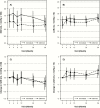Early Antiretroviral Therapy at High CD4 Counts Does Not Improve Arterial Elasticity: A Substudy of the Strategic Timing of AntiRetroviral Treatment (START) Trial
- PMID: 27942541
- PMCID: PMC5144656
- DOI: 10.1093/ofid/ofw213
Early Antiretroviral Therapy at High CD4 Counts Does Not Improve Arterial Elasticity: A Substudy of the Strategic Timing of AntiRetroviral Treatment (START) Trial
Abstract
Background: Both human immunodeficiency virus (HIV) infection and antiretroviral therapy (ART) may increase cardiovascular disease (CVD) risk. Vascular function assessments can be used to study CVD pathogenesis. We compared the effect of immediate versus deferred ART initiation at CD4 counts >500 cells/mm3 on small arterial elasticity (SAE) and large artery elasticity (LAE).
Methods: Radial artery blood pressure waveforms were recorded noninvasively. Small arterial elasticity and LAE were derived from analysis of the diastolic pulse waveform. Randomized treatment groups were compared with linear models at each visit and longitudinal mixed models.
Results: Study visits involved 332 participants in 8 countries: mean (standard deviation [SD]) age 35 (10), 70% male, 66% nonwhite, 30% smokers, and median CD4 count 625 cells/mm3 and 10-year Framingham risk score for CVD 1.7%. Mean (SD) SAE and LAE values at baseline were 7.3 (2.9) mL/mmHg × 100 and 16.6 (4.1) mL/mmHg × 10, respectively. Median time on ART was 47 and 12 months in the immediate and deferred ART groups, respectively. The treatment groups did not demonstrate significant within-person changes in SAE or LAE during the follow-up period, and there was no difference in mean change from baseline between treatment groups. The lack of significant differences persisted after adjustment, when restricted to early or late changes, after censoring participants in deferred group who started ART, and among subgroups defined by CVD and HIV risk factors.
Conclusions: Among a diverse global population of HIV-positive persons with high CD4 counts, these randomized data suggest that ART treatment does not have a substantial influence on vascular function among younger HIV-positive individuals with preserved immunity.
Keywords: HIV infection; antiretroviral therapy; arterial elasticity; cardiovascular disease; vascular dysfunction..
© The Author 2016. Published by Oxford University Press on behalf of the Infectious Diseases Society of America.
Figures


References
-
- Seaberg EC, Muñoz A, Lu M, et al. Association between highly active antiretroviral therapy and hypertension in a large cohort of men followed from 1984 to 2003. AIDS 2005; 19:953–60. - PubMed
-
- El-Sadr WM, Lundgren J, Neaton JD, et al. CD4+ count-guided interruption of antiretroviral treatment. N Engl J Med 2006; 355:2283–96. - PubMed
Grants and funding
LinkOut - more resources
Full Text Sources
Other Literature Sources
Research Materials

